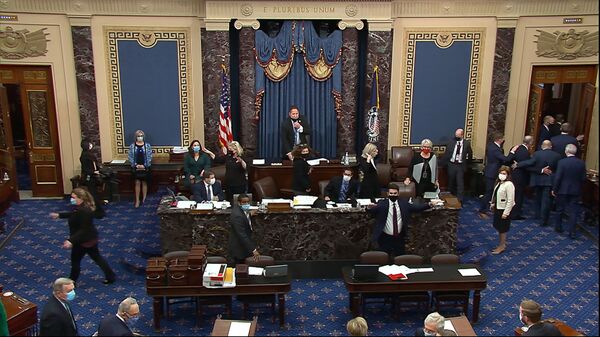The Democratic Party has secured a majority in both chambers of the US Congress in the first years of Joe Biden's presidency, with the help of two seats won by the Dems in the recent Georgia run-off election and the tie-breaking vote of Vice President Kamala Harris, who will be the president of the upper chamber. It does not necessarily mean, however, that the Democrats will have carte blanche at passing ambitious legislation or approving cabinet candidates.
The 50-50 split in the upper chamber of the US Congress is rare, occurring only three times in the nation's history. Here is how a new split Senate of the 117th US Congress will function.
No Democrat Voices Left Behind
The narrow majority forces the Democratic Party to look closely after its Senators, as losing even a single vote could mean defeat in crucial legislation. At the same time, a simple majority may not be sufficient in every scenario.
One of the first decisions for the Senate as it reconvenes after 20 January will be an organizing resolution, which requires a 60-vote majority instead of 51, according to Senate regulations. The resolution not only defines the procedures under which the upper chamber works or the cabinets the Senators get, but also determines the membership and leadership of upper chamber committees.

This means that Republicans will have at least some leverage in how committees are formed. The last time the chamber was split 50-50 between the parties was in 2001, and the two agreed to share power and committees as well as consented to resolve committee impasses on the Senate floor. It is possible that the current minority and majority Senate leaders will draw inspiration from the 107th Congress and arrive at a similar scheme, but the outcome is not a foregone conclusion.
Threat of Filibuster Remains
While passing most motions, legislation and candidate appointments requires 51 votes secured by the Democrats with the Harris vote, in reality, the Democrats will have to secure 60 votes to pass many, meaning they will need to gain the support of at least 10 Republicans, while not losing a single Democrat.
The majority party rarely presents a bill to the floor without being confident of it being supported by three-fifths of the chamber, due to the threat of a filibuster – when an opposition voice tries to bury the bill in endless debate. The main way to overcome a filibuster is to pass a so-called cloture motion introduced under Rule 22. If supported by at least 60 Senators, it allows forcing a simple majority vote on any bill, bypassing endless debates.
Can Democrats Overcome A Filibuster Without GOP Support
Filibusters and cloture motions are relatively rare in US politics, but have become increasingly common in the last few decades. Numerous Senators have sought to ban them for good, but these initiatives were ironically filibustered themselves, after not gaining the support of 60 Senators.
While Biden has promised to consider eliminating the practice, the chances of him gaining enough support to do it are slim, since it is the main tool of any minority party to keep opponents from gaining an advantage. The last time a majority party had control over 60 seats or more was in the 95th Congress, over 40 years ago.

Democrats have several ways of overcoming GOP filibusters, however, making use of their 51-vote majority. Certain bills, such as those related to the budget or spending matters can be pushed through a "reconciliation" procedure, which limits the debate time to 20 floor hours, meaning it would be voted regardless of filibuster attempts, with only a simple 51-vote majority required.
The move can only be pulled once a year, however, and not with every bill. Democrats might take advantage of another precedent set in 2013 and 2017, however, which allows a majority party to pass cabinet and justices nominations with a simple 51-vote majority. The majority party may also set new precedents using a so-called 'nuclear option', which allows any Senator to raise a point of order claiming that a Senate rule is being violated by the opposition's filibuster, thus forcing the Senate to vote on the matter, which, again, requires a simple 51-vote majority.
What Does This Mean for Democrats and the Biden Administration?
Although the arrangement of the 117th Congress, which starts work after Joe Biden's nomination, is relatively rare, it is not so different from previous political layouts in the upper chamber. The main difference is that Democrats will have to find more allies for their initiatives among Republicans while keeping a close eye on potential defectors within their own ranks.
The GOP has the power to torpedo most of their opponent's initiatives, if they escalate a confrontation with Democrats, at whoich time, the Dems would largely rely on the GOP's willingness to cooperate, undermining what may be considered by some as the more radical initiatives of the Biden-Harris administration. Republicans might also end up in a similar situation in several years, meaning they are unlikely to oppose any Democratic bill and will try to cooperate on some matters. Democrats could also try to push through crucial initiatives through the nuclear option, but the success of these scorched-earth policies is not guaranteed.




